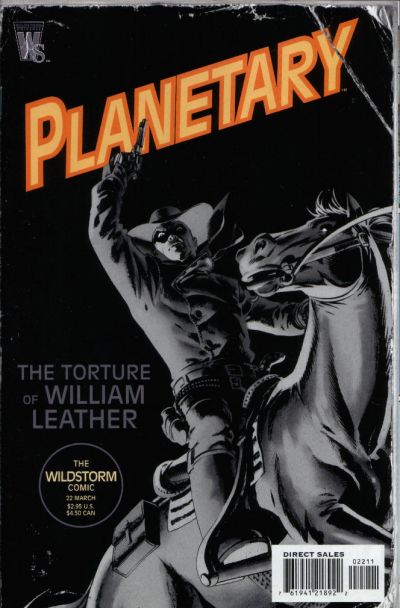I was convinced I had read every Planetary story ever published, but turns out I was wrong. The same thing happened to me with Young Avengers in 2013, I started with the first issue and I didn’t know there was a special preview that I ended up acquiring at a later date. So in both cases I ended up reading what would be issue # 0 a long time after I had read everything.
“Nuclear Spring” was originally published as a backup story in Gen13 # 33 (September 1998), published by Image. That is certainly something interesting, as DC was still in the process of acquiring Wildstorm, an imprint that was part of Image / Homage Comics (a subsidiary of Jim Lee’s Aegis Entertainment) at the time. Planetary # 1 is announced as a new title coming out in 4 months, and there is even a beautiful pencil drawing by Cassaday as part of the advertising. However, seems like the acquisition process took longer than expected, and exactly a year later, DC would be publishing Planetary # 1, under the independent imprint of Wildstorm (which disappeared in 2010).
“Sometimes, ordinary people uncover things that are best left covered. Sometimes, things best left covered emerge into ordinary life and do not have the world’s best interests at heart. These are times when Planetary arrive -invited or not…”, that’s what Planetary is about. And certainly, this first story shows us the Archeologists of the Impossible doing what they do best.
Warren Ellis comes up with a captivating story about a scientist who has created a “quantum box” for “rotating things out of reality”. However, when they test this new invention, the scientist must save the life of the woman he loves, who has accidentally stumbled onto the testing site. Exactly as it happens with the Hulk, the scientist receives the full impact of the explosion and he transforms himself into a monster far more inhuman than the Hulk.
Cassaday’s art is wonderful, although not as depurated as it would become later, he’s still transitioning from his late 90s style, which we were able to see in titles like Ka-Zar or Union Jack. However, the cover is absolutely exquisite. Just the design and the composition are miles ahead of anything else that was being published at the time, and Cassaday’s attention to details brings a unique sense of elegance to the cover. Truly magnificent!
________________________________________________________________________________________________________
________________________________________________________________________________________________________
Estaba convencido de haber leído todas las historias de Planetary, pero resulta que estaba equivocado. Me pasó lo mismo con Young Avengers en 2013, comencé con el primer número y no sabía que había un preview especial que terminé adquiriendo en una fecha posterior. Así que en ambos casos terminé leyendo lo que sería el número 0 mucho tiempo después de haber leído todo lo demás.
“Primavera nuclear” se publicó originalmente como una historia de respaldo en Gen13 # 33 (setiembre de 1998), publicado por Image. Eso es ciertamente algo interesante, ya que DC todavía estaba en el proceso de adquirir Wildstorm, una marca que era parte de Image / Homage Comics (una subsidiaria de Aegis Entertainment de Jim Lee) en ese momento. Planetary # 1 se anuncia como un nuevo título que saldrá en 4 meses, e incluso hay un hermoso dibujo a lápiz de Cassaday como parte de la publicidad. Sin embargo, parece que el proceso de adquisición tomó más tiempo de lo esperado, y exactamente un año después, DC publicaría Planetary # 1, bajo el sello independiente de Wildstorm (que desapareció en 2010).
“A veces, la gente común descubre cosas que es mejor dejar cubiertas. A veces, las cosas que se dejan cubiertas emergen de la vida cotidiana y no tienen en cuenta los mejores intereses del mundo. Son momentos en los que Planetary llega, invitado o no...”, de eso se trata Planetary. Y ciertamente, esta primera historia nos muestra a los Arqueólogos de lo Imposible haciendo lo que mejor saben hacer.
Warren Ellis presenta una historia cautivadora sobre un científico que ha creado una "caja cuántica" para "rotar cosas fuera de la realidad". Sin embargo, cuando prueban este nuevo invento, el científico debe salvar la vida de la mujer que ama, quien accidentalmente ha irrumpido en el sitio de prueba. Exactamente como sucede con Hulk, el científico recibe todo el impacto de la explosión y se transforma en un monstruo mucho más inhumano que Hulk.
El arte de Cassaday es maravilloso, aunque no tan depurado como lo sería más tarde, todavía está en transición en su estilo de finales de los 90s, que pudimos ver en títulos como Ka-Zar o Union Jack. Sin embargo, la portada es absolutamente exquisita. Sólo el diseño y la composición están muy por encima de cualquier otra cosa que se publicara en aquellos años, y la atención de Cassaday por los detalles aporta una sensación única de elegancia a la portada. ¡Una verdadera maravilla!






































